What’s new?
We Indians love big, traditional SUVs. We love the size, we love the imposing stance and we absolutely love the big ground clearance that allows us to drive roughshod over our roads. Of course, the unwritten rule here is ‘the bigger the better’, and who better to implement that than past masters Chevrolet, who, through past experience, know every single SUV trick in the book. And let’s be clear, the Trailblazer is a big, big SUV, even by class standards. Built on a new-gen ladder-frame chassis, it stretches the tape in all directions. It’s 173mm longer than the current favourite, the Fortuner, and wider and taller too.
The Fortuner, however, has been one of the most successful SUVs in India. Toyota’s largest selling car after the Innova here, despite the presence of smaller, cheaper cars like the Etios and the Liva, the Fortuner is a, tough, tough competitor. It is dependable, as strong as a sledgehammer and extremely capable. Updated as recently as this year, the mildly facelifted Fortuner is also an SUV that gets every single thing right. So, the Chevrolet has an extremely difficult match on hand. It has to outshine it in every department to draw customers to it. And then there’s the strong Toyota brand it has to battle against; not a trifling challenge by any stretch. So, can the big Chevy displace the Fortuner or does the king-of-the-hill still retain top slot?

What are they like to drive?
The Duramax 2.8-litre four-cylinder diesel engine in the Trailblazer makes a very strong 197bhp. So, despite the 2,068kg weight, the Trailblazer is very quick off the mark. It dismisses the 0-100kph sprint in a blistering 9.89 seconds and that, for a vehicle of this mass, is clearly impressive. Performance is even good in the real world, where a mere tap on the accelerator is all that is needed to get this beast moving smartly after only a bit of a delay or turbo lag. The Trailblazer, in fact, is an impressive cruiser as the pulling power of the engine and the six-speed automatic gearbox keep the Chevy moving forward effortlessly. And that’s not all, it’s also pretty impressive when you are in a hurry. Want a quick burst of acceleration and the six-speed gearbox even shifts down fairly quick, power flowing to the rear wheels soon after. In manual tiptronic mode, one can even spin the motor all the way to 4800rpm, but the engine gets noisy at these speeds, so it’s best to keep revs below 3600rpm. What must be remembered is that, specified as it is, this Chevy is not built for driving on very challenging off-road trails. There’s no four-wheel drive or low range and this means the fantastic 253mm clearance and the big tyres are wasted on really challenging terrain.
The specification sheet of the Fortuner reads, 3.0-litre D-4D. But while the Toyota has the larger capacity engine, it makes less power at 168bhp. Despite this, initial performance is more immediate. The Toyota is quicker on the draw when you hit the accelerator and the responsive engine also feels smoother than the Chevy. As a result, it is slightly nicer to drive in traffic and is also the more refined of the two. The Toyota, however, gets left behind once the roads open up. It lacks the sheer grunt of the Chevrolet and its straight line acceleration is nowhere near as quick. The heavier, permanent four-wheel-drive system automatic tested here takes a leisurely 12.32 seconds to sprint from 0-100kph and the gap between it and the Chevrolet only widens as you go faster.
In addition, it is the Chevy that also has the nicer gearbox, the Toyota’s five-speed gearbox is not as quick to respond. A lot can be gleaned from the following. In kickdown, the Toyota takes 7.39 seconds from 20-80kph and 10.86 seconds to go from 40-100kph. The Chevy does the same in 5.64 seconds and 7.33 seconds, respectively.
The Chevrolet also rides better than Toyota. Underneath the Chevy’s big body is a rugged ladder-frame chassis which gives it the ability to muscle through bad roads. And while the Fortuner feels tough, the Trailblazer feels tougher still. This helps it feel more composed while tackling larger bumps and big craters, the more supple suspension absorbing shocks better. There are vertical movements, expected from a vehicle this tall, but overall, it feels quite composed. Even passengers sitting in the third row don’t complain too much and that’s the best part about the Trailblazer.
Just like the Chevy, the Fortuner also sits on a ladder-frame. The low-speed ride here is slightly lumpy and the passengers get tossed around a bit. One can feel the road undulations more here and it never feels properly settled at slow speeds. However, go faster and the ride improves. High-speed stability is also good, and the car displays good grip with the full-time four-wheel-drive system making its presence felt at times.
But neither of these big and heavy off-roaders are truly enjoyable to drive if you employ an attacking driving style. These just aren’t the right kind of vehicles. The Fortuner rolls a fair bit, but grip levels are decent and the fairly direct heavy steering adds to the sense of security despite the mass of the car being flung around from side to side. So, overall, handling is decent for a vehicle this big.
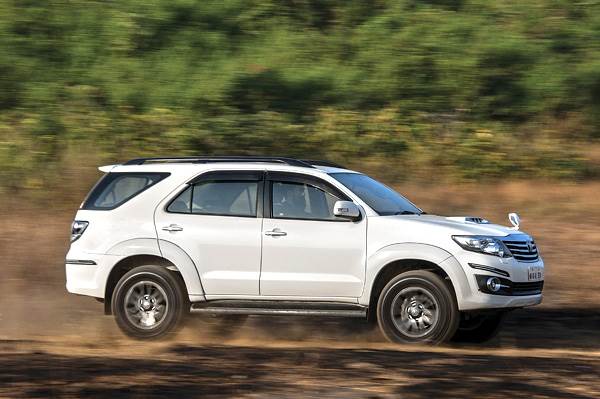
The Trailblazer sits 253mm above ground and its skyscraper-like tall dimensions mean there’s even more body roll and you can feel the weight shifting around corners.
It can still be driven fast around corners, but there’s a bit more drama here with tyres squealing, and it doesn’t feel as compact or as composed as the Toyota. Still, grip levels are quite good and the handling is quite acceptable. The Chevy has the lighter and faster steering of the two, and this makes it easier to manoeuvre in traffic.
What are they like inside?
The Trailblazer’s tall cabin has a well laid out two-tone dashboard which looks quite upmarket. The design is very functional and user friendly, and most functions are instinctive to use. Despite the interior design not standing out as something extra special and quality being average, the functionality of the cabin stands out. It is easy to relax because there’s acres and acres of space here and because the big seats provide so much comfort, you truly relax as soon as you climb in. In addition, the Mylink touchscreen audio system is simple to use and is placed at eye level and even plays your movies.

There is a bit of style. The ‘square’ instrument pods with their retro numerals look quite similar to Chevy’s sportscar, the Camaro and the three-spoke steering has also been taken from the same place. There’s also a multi-info display in between the speedometer and the tachometer which, among others, uniquely tells you about the number of hours your engine has run.
The front seats stand out because they are large and comfy and beautifully contoured. Even the cushioning is near perfect and Chevy has been good enough to provide you a commanding view over the bonnet. Moving back, the space in the second row is good too – headroom, legroom and kneeroom is befitting that of a big vehicle tag. What’s surprising is that even the third row can fit an adult, without fighting for space. The middle row seats don’t move ahead, but legroom in the third row is still acceptable and where it really scores is headroom; even a six-footer’s head won’t brush against the roof. There’s also enough storage space; each door gets a bottle holder and there’s provision for the same even for third-row passengers.
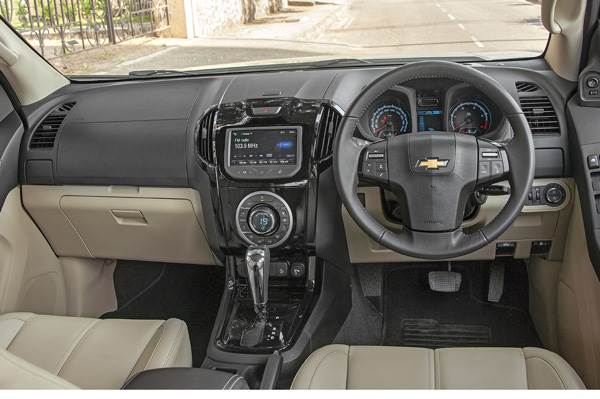
The Toyota’s cabin, despite the new touchscreen system, is now showing its age. It looks even less attractive and the backlit instrument cluster looks just about average. The touchscreen system is quite simple to use, it can play videos and has navigation, and doubles up as the display for the rear-view camera, but the system looks distinctly aftermarket. The all-black dashboard, however, doesn’t provide that essential premium feel, which you’d expect on a Rs 26-lakh car. The cabin isn’t as spacious as the Chevy’s either. The front seats are quite comfy though, and there’s ample legroom, headroom and kneeroom in front. The second row can be moved forward and back and as a result, seems to offer those crucial millimetres of extra space over the Trailblazer, but the seats aren’t so great and it still feels a bit cramped here. Where the Fortuner gets completely outclassed is when you step into the third row. Space is tight here, especially headroom and you are sat much lower than in the Trailblazer. Where the Fortuner’s cabin does match the Chevy’s is in practical spaces – all doors and even the third-row have bottle holders.
Buying & owning
The Trailblazer is available in just one trim – LTZ which is the fully loaded variant. It costs Rs 26.40 lakh (ex-showroom, Delhi) and is available only with two-wheel drive and an automatic gearbox. General Motor’s sales and service network is still not up to scratch but it’s offered with a warranty of three years/1,00,000km.
When it comes to the Fortuner, there are six variants to choose from — 2.5 Sportivo 4X2 MT, 2.5 Sportivo 4X2 AT, 3.0 4X2 MT, 3.0 4X2 AT, 3.0 4X4 AT and 3.0 4X4 MT. Prices for the range start from Rs 24.17 lakh going up to Rs 27.02 lakh. The 3.0 4X4 AT is priced at Rs 27.02 lakh which is Rs 62,000 dearer than the Trailblazer. Toyota also offers a warranty of three years/1,00,000km. When it comes to dealership network and after sales service, Toyota also trumps GM.
Equipment & safety
The Trailblazer is available in only one trim – LTZ and gets a seven-inch Mylink touchscreen infotainment system with Bluetooth telephony and steering-mounted audio controls. There is aux-in and a USB port, and you can play your favourite videos as well. It gets automatic climate control at the front and also for the second row occupants. The electric front seats are fully adjustable but don’t offer buttons for lumbar support. Cruise control buttons are placed on the steering wheel which is convenient on long distance drives. There are two airbags and ABS with EBD, ESP, cornering brake control, hill start assist, hill descent control and traction control system. The Fortuner is available in six variants, but the 4X4 AT is the top-spec model and it gets a touchscreen infotainment system just like in the Chevy. This system is pretty basic and functional but doesn’t have a nice display like in the Chevy. It also gets fully adjustable electric front seats and no button for lumbar support. There are two airbags in total along with ABS + EBD and vehicle stability control.
Both the Chevy and Toyota come equipped with follow-me-home headlamps and reverse camera but Fortuner gets 4X4 and low-range.
Verdict
The Fortuner has been around for six years now and has a stranglehold on the big SUV segment. It’s held on to this lead over all the years with its combination of its tough build, decent space a powerful engine and reliability, all bundled together in a superbly supported package. And this all-wheel-drive version is fantastic off road too. The big Chevy, however, is also an SUV that really packs it in. It has no four-wheel-drive, and that’s a serious shortcoming, but, for regular folks looking at everyday use, this is an SUV that does almost everything a little bit better than the Fortuner, be it performance, roominess, utility, ride or sheer size. The styling could have had a bit more character, and Chevrolet offers it in just one variant, but the Trailblazer still pips the Fortuner to the post. Toyota needs to bring the new Fortuner here post haste.

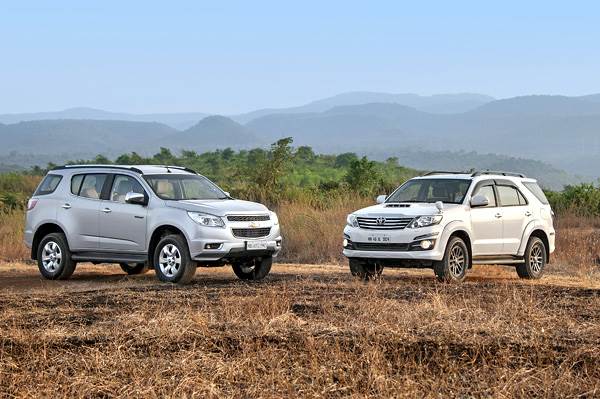
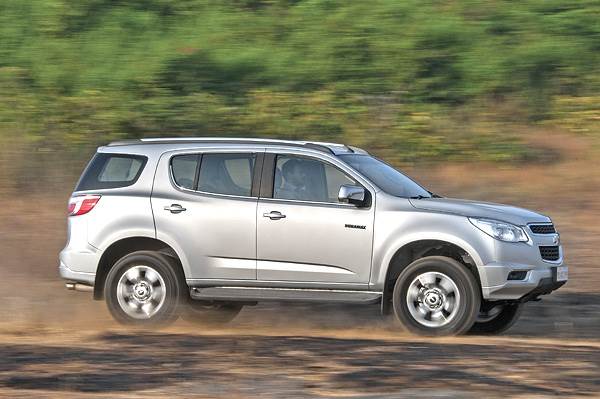
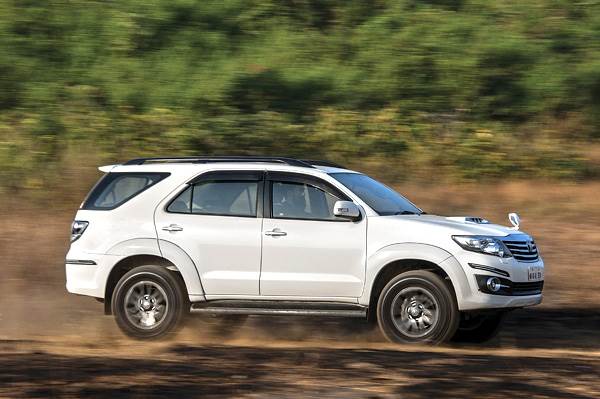
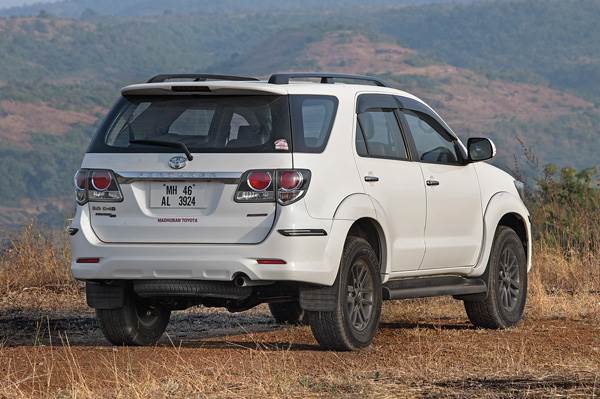

Comments
Member Login
Personal Details
No comments yet. Be the first to comment.